2. 中国科学院地球科学研究院, 北京 100029;
3. 中国科学院大学地球与行星科学学院, 北京 100049
2. Institutions of Earth Science, Chinese Academy of Sciences, Beijing 100029, China;
3. College of Earth and Planetary Sciences, University of Chinese Academy of Sciences, Beijing 100049, China
条带状铁建造(Banded iron formations,BIFs)是一种含铁量大于15%,以铁的氧化物(磁铁矿、赤铁矿)、碳酸盐、硅酸盐、石英(燧石)以及硫化物为主要成岩矿物,富硅层(ca. 40%~60% SiO2)与富铁层(ca. 20%~40% Fe)呈条纹-条带状互层产出的一种海相化学沉积(James, 1954; Klein, 2005; Li et al., 2011; Posth et al., 2011; Trendall, 2002)。BIFs在全球具有广泛分布,其最早形成距今3.8~3.7Ga(Moorbath et al., 1973),主要集中形成于晚太古代-古元古代(2.7~1.8Ga)和新元古代(0.8~0.6Ga)(Posth et al., 2011;王长乐等, 2011),是早前寒武纪地球生物、海洋、大气等演化的重要研究对象(Trendall, 2002;兰彩云等, 2013;吴文芳等, 2012;赵振华, 2010)。
BIFs中的磁铁矿被普遍认为是在成岩或变质过程中转变生成的矿物。然而,研究者通过实验模拟和对哈默斯利(Hamersley)BIFs中的磁铁矿研究发现二者的δ56Fe均小于零,因而推论BIFs中的磁铁矿可能来自微生物异化还原作用(DIR)(Crosby et al., 2007; Johnson et al., 2008)。Raye et al. (2015)通过研究形成于1.88Ga的仓库番组(Sokoman)中BIF的铁同位素认为BIFs中铁同位素真实记录沉积环境状态而非记录微生物作用。最近,Konhauser et al. (2017)通过研究哈默斯利(Hamersley)BIF中的微量元素认为浮游植物在BIF形成中扮演着重要角色。存在这些争议的原因之一在于在一定的地质条件下磁性矿物之间可以相互转化,如:Otake et al. (2010)通过模拟发现在一定温压条件下(T=100~250℃,PH2=0.05~5MPa)的热液流体中赤铁矿可以转化为磁铁矿。准确识别BIFs中磁性矿物的种类,含量及成因是最终解决这些争议问题的重要前提。
本研究针对南非巴伯顿绿岩带(Barberton Greenstone Belt)无花果树群恩圭尼亚(Ngwenya)组的BIFs样品,采用岩石磁学方法与电镜观察结合,分别对富硅层和富铁层岩石样品的磁学性质和磁性矿物组成进行系统研究,并初步讨论了磁铁矿可能的成因。
1 地质概况巴伯顿绿岩带位于非洲南部卡普瓦尔(Kaapvaal)克拉通盆地东缘,发育NE-SW走向的表壳岩石层序,称为斯威士兰(Swaziland)超群(ca. 3350~3220Ma)。层序自下而上,分为昂维瓦科特群(ca. 3350~3300Ma):主要发育科马提岩、科马提质玄武岩、长英质火山岩以及海相沉积岩;无花果树(Fig Tree)群(ca. 3260~3226Ma):主要发育硅质碎屑岩与长英质火山岩;木迪斯(Moodies)群:主要发育石英砂岩。巴伯顿绿岩带长约130km,宽约10~35km,厚约4~5km,被多期花岗岩体(ca. 3510~3100Ma)侵入,是典型的古太古代表壳沉积构造带(Hofmann, 2005)。
本研究BIFs样品采自位于巴伯顿绿岩带中部无花果树超群(图 1a)。无花果树超群自下而上分为罗南(Loenen)组、恩圭尼亚(Ngwenya)组和曼普(Mapepe)组(Heinrichs et al., 1980)。罗南组发育碳-铁质页岩以及中厚层硅质粉砂岩;恩圭尼亚组发育铁质页岩、条带状铁建造及杂砂岩;曼普组主要发育结构成熟度高、分选磨圆好的砂岩(图 1b)(Hofmann, 2005; Krüner et al., 1991)。恩圭尼亚组中BIF样品发育良好的毫米级到厘米级的富铁层和富硅层互层构造(图 1c)。
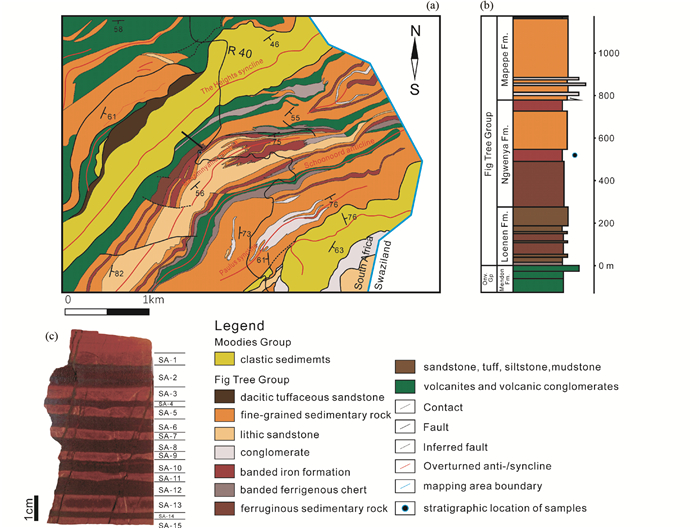
|
图 1 研究区地质简图及实验样品 (a)研究区地质简图(据Lowe et al., 2012修改),采样点如箭头所示;(b) Inyoka断裂带南部无花果树超群地层柱状图(据Hofmann, 2005修改);(c)实验样品剖面照片和分层样品编号 Fig. 1 The brief geological map of investigated area and experimental samples (a) the concise geological map of study area (modified after Lowe et al., 2012), stratigraphic location of samples is pointed by solid circle with blue edge; (b) stratigraphic column of Fig Tree group from south of the Inyoka Fault (modifiedafter Hofmann, 2005); (c) image of sample section and specimen numbers |
使用STX-202A型金刚石线切割机将BIFs样品按富硅层和富铁层逐层进行切割,编号为SA-n(n=1, 2…, 15)(图 1c)。磁滞回线、饱和等温剩磁获得曲线和反向退磁曲线、一阶反转曲线(FORC)均利用MicroMag3900型振动样品磁力仪完成(灵敏度0.5×10-9Am2)。获得的磁滞回线与等温剩磁曲线原始数据利用Grapher 9.0处理完成,矫顽力谱分析根据Kruiver et al. (2001)提出的模型进行分析。FORC数据采用FORCinel 3.06程序在IGOR PRO 8软件中处理完成。低温磁学性质利用MPMS-XL5超导量子干涉仪进行测量;该仪器温度范围2~400K,磁场范围0~5.5T,剩余磁场精度0.1%,灵敏度为5×10-11Am2。本次选择SA-1~SA-8为代表样品,获得了其在20~300K的零场冷却曲线(ZFC)和有场冷却曲线(FC),并对有场冷却曲线进行一阶求导,计算Verwey转变温度与Morin转变温度。Lowrie三轴实验利用TD-48热退磁炉进行热退磁,随后用2G超导磁力仪(755)测试完成。磁化率及磁化率随温度变化曲线(k-T曲线)在卡帕桥磁化率仪(MFK)进行。测量k-T曲线时,外场为200A/m,频率为976Hz,温度范围为40~700℃,加热速率12℃/min,所有样品测量加热和冷却过程均在氩气中进行。电子显微学研究在Nova NanoSEM 450场发射扫描电子显微镜上完成。
本研究全部实验均在中国科学院地质与地球物理研究所完成。岩石磁学实验在古地磁与年代学实验室完成,电子显微学观测在电子探针与扫描电镜实验室完成。
3 实验结果除个别样品(SA-15)外富铁层的磁化率(χ)、剩余磁化强度(Mrs)、饱和磁化强度(Ms)、剩磁矫顽力(Hcr)、矫顽力(Hc)均显著高于富硅层各参数的值(表 1)。
|
|
表 1 BIFs样品的岩石磁学测试结果 Table 1 Rock magnetic results of BIFs |
图 2分别为富硅层(SA-3、SA-7)和富铁层(SA-4、SA-10)代表性样品的磁滞回线。由磁滞回线可见富硅层与富铁层样品均具有较高的矫顽力(Hc)与剩磁矫顽力(Hcr)。图 2中磁滞回线在0.25T时均已获得饱和磁化强度的90%,在1T左接近饱和,富硅层饱和磁化强度(Ms)与剩余磁化强度(Mr)远小于富铁层,如图 2中SA-3样品的Ms、Mr分别为54.9mAm2/kg、17.6mAm2/kg,SA-4样品的Ms、Mr分别为778.1mAm2/kg、210.9mAm2/kg。形态上SA-3、SA-7的磁滞回线呈现陡直的特征,表明其载磁矿物主要为假单畴(PSD)磁铁矿;SA-4、SA-10的磁滞回线呈现典型的“鹅颈形”特征,表明样品中含有两种不同类型(粒度、种类)的磁性矿物。

|
图 2 代表性样品的磁滞回线 SA-3、SA-7:富硅层样品;SA-4、SA-10:富铁层样品;图 3、图 4同 Fig. 2 The typical hysteresis loops of silica-rich layer (SA-3, SA-7) and iron-rich layer (SA-4, SA-10), respectively |
图 3为代表性样品的等温剩磁(IRM)获得曲线、反向场退磁曲线及矫顽力谱分析结果。实验中施加最大外场为1.5T和1.2T。图 3中SA-3、SA-7为富硅层样品,该样品的等温剩磁在0.6T左右获得SIRM的90%,随后随外场增加缓慢上升,表明该样品中剩磁信号主要为高矫顽力硬磁性矿物(赤铁矿)的贡献。对其矫顽力谱分析发现,SA-3样品中主要含有两种高矫顽力的磁性矿物(component 1、component 2),B1/2分别为370.1mT、149.3mT,同时含有少量低矫顽力的磁性矿物(component 3),B1/2为17.8mT;这三种组分的相对含量分别为59%、37%和4%(表 2)。与其类似,SA-7样品中同样含有两种高矫顽力组分(component1、component2)和一种低矫顽力组分(component3),B1/2分别为370.9mT、72.5mT和23.1mT,相对含量分别为62%、28%和10%(表 2)。
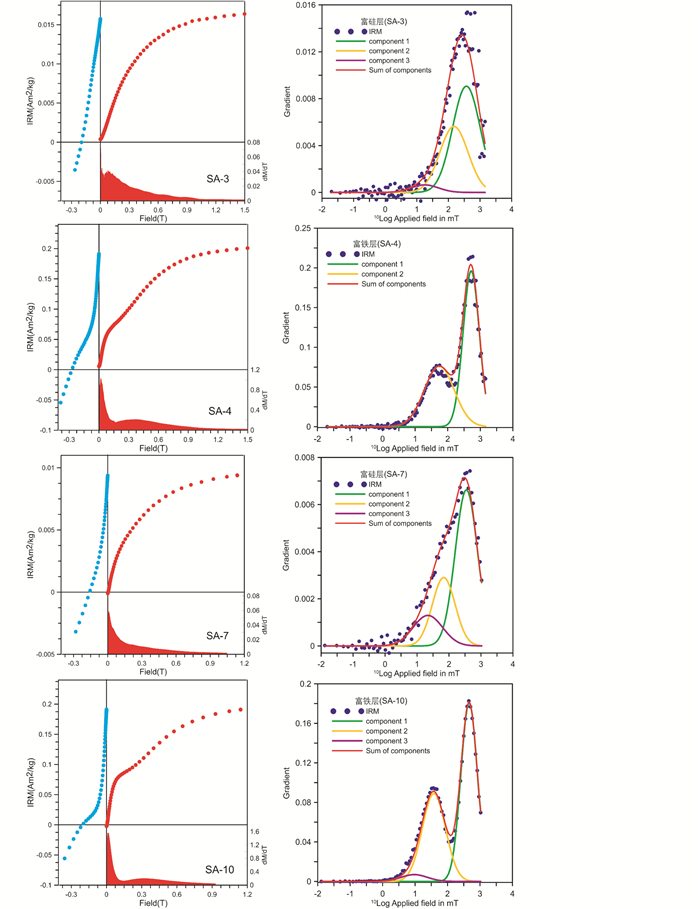
|
图 3 代表性样品的等温剩磁获得曲线、反向场退磁曲线及矫顽力谱分析 Fig. 3 Acquisition curves and back-field curves of isothermal remanent magnetization (IRM) and cumulative log Gaussian analysis curves for typical specimens of BIFs |
|
|
表 2 矫顽力谱分析结果 Table 2 Results of cumulative log Gaussian analysis curves for BIFs |
图 3中SA-4与SA-10为富铁层典型样品的测量结果,该类样品的SIRM获得曲线呈两阶段特征,开始迅速上升,在0.1T获得SIRM的30%,随后随外场增加而缓慢增加,1T时依旧呈现缓慢上升的趋势,表明该样品中至少含有高、中矫顽力两种不同的磁性矿物。矫顽力谱分析也证实不同矫顽力磁性矿物的存在,SA-4中主要含有高矫顽力磁性矿物(component 1),B1/2为524.8mT,其相对含量为58%,中矫顽力磁性矿物(component 2),B1/2为55.0mT,其相对含量为42%(表 2)。SA-10中含有三种不同矫顽力组分(component1、component2、component3),B1/2分别为491.8mT、40.5mT和10.0mT,相对含量为58%、40%和2%(表 2)。
3.3 FORC图FORC图可以有效反映样品中磁性矿物的磁畴类型以及磁性矿物之间静磁相互作用力大小(Roberts et al., 2014; Roberts et al., 2000;秦华峰等, 2008)。图 4分别为富硅层(SA-3、SA-7)和富铁层(SA-4、SA-10)代表性样品的FORC图。从图中可以发现,富铁层磁化强度明显强于富硅层。图 4中密度函数等值线主要表现为中间区域闭合逐渐向外围变成半封闭、以Hu=0为轴呈近对称分布,其中SA-3、SA-7中密度函数等值线在纵向延伸范围广,表明SA-3、SA-7中主要为超顺磁、假单畴磁性颗粒为主,而SA-4、SA-10中主要为假单畴和多畴颗粒为主。此外,富硅层与富铁层的FORC图等值线中心最大值约为8mT,纵向上富硅层样品中磁性相互作用力大小为-5~5mT,富铁层样品中磁性相互作用力大小为-10~10mT,说明样品中主要为低矫顽力的且相互作用力较弱的磁性矿物。富硅层中磁性相互作用力小于富铁层。
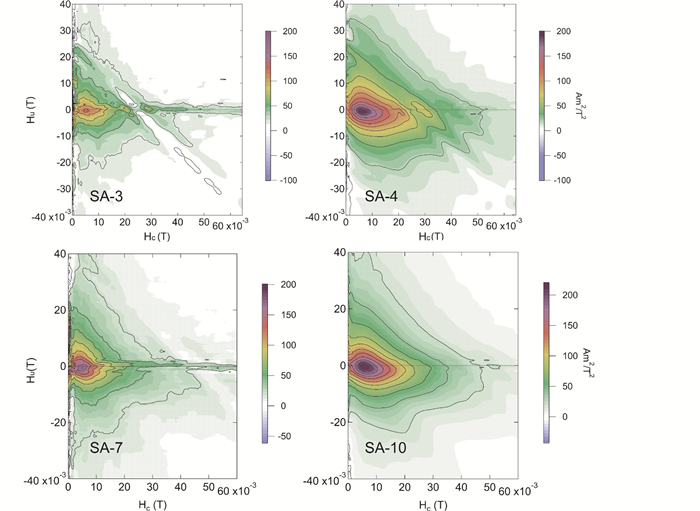
|
图 4 代表性样品的FORC图(平滑因子为5) Fig. 4 First-Order Reversal Curve diagram (FORC) for typical silica-rich layer and iron-layer (SF=5) |
通过低温磁学分析可以获得室温和高温磁学分析无法获得的重要信息,如低温磁学测量可通过确定磁性矿物特有的相变温度来鉴别样品中磁性矿物类型,标准化学计量合成的磁铁矿、生物成因磁铁矿、磁黄铁矿和赤铁矿的相变温度分别为120~125K(Muxworthy and McClelland, 2000; Verwey, 1939)、100~110K(Moskowitz et al., 1993; Pan et al., 2005a, b ; 潘永信等, 2004)、30~34K(Rochette et al., 1990)和250~261K(Özdemir et al., 2008)。图 5a, b分别为富硅层与富铁层代表性样品的低温磁学性质图。通过对有场冷却曲线(FC)一阶求导可以发现,富硅层在~25K出现首次相转变,图 5a中黄色区域,而在富铁层并未观察到这种现象。富铁层在124K左右出现Verwey转变(Tv),图 5b中浅红色区域,而富硅层则在104~107K、121~124K出现两次Verwey转变,呈现双Tv特征,图 5a中绿色与浅红色区域。此外,富硅层与富铁层在250~260K均出现典型的Morin转变(Tm),图中蓝色区域。
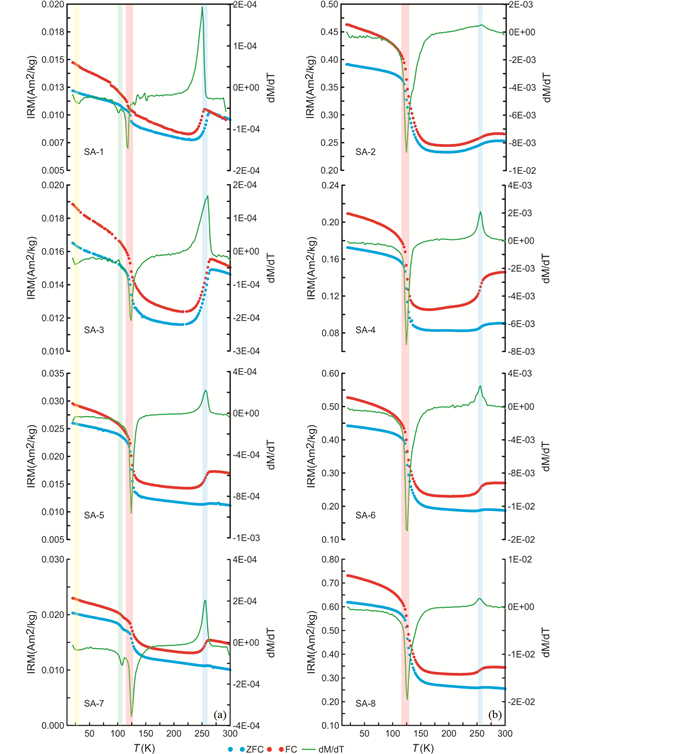
|
图 5 部分富铁层和富硅层代表性样品的低温磁学测量结果 ZFC-零场冷却曲线;FC-有场冷却曲线;dM/dT-FC的一阶导数 Fig. 5 Partial low-temperature results of typical silica-rich layers and iron-rich layers Zero Field Curve (ZFC), Filed Curve (FC) and its first-order derivative (dM/dT) |
升温曲线在Verwey转变温度(Tv)之前,剩磁缓慢下降,比较而言,富硅层中剩磁下降幅度略大于富铁层,但当温度达到Tv时,富铁层中剩磁下降幅度明显大于富硅层。温度达到Tm时,剩磁迅速上升随后开始缓慢下降。我们注意到,除SA-1样品在260~300K内有场冷却曲线(FC)与零场冷却曲线(ZFC)重叠外,其余样品在整个温度范围(20~300K)内FC、ZFC均未出现重叠。
3.5 Lowrie三轴实验不同类型的磁性矿物具有各自不同的矫顽力和各自的解阻温度,通过对互相正交的三分量IRM进行逐步退磁可以表征样品中磁性矿物特征(Deng et al., 2013; Lowrie, 1990)。图 6a, b为富铁层(SA-4)和富硅层(SA-13)的Lowrie三轴热退磁曲线,即在室温下沿着样品的Z轴、Y轴、X轴方向添加2.5T、0.5T和0.05T的外场使之获得IRM,随后进行逐步热退磁,图 6c为富硅层、富铁层所有样品的IRM逐步热退磁曲线,由于富铁层样品磁性太强,中低温(< 500℃)测试阶段仪器漂移过大,除少数外样品外,无法获得可靠数据,故选取了520℃以上的测试结果。从图 6a, b中可以发现低矫顽力载磁矿物携带的剩磁在560~580℃明显下降,表明该类载磁矿物为磁铁矿;中、高矫顽力载磁矿物携带的剩磁在660~680℃急剧下降,表明载磁矿物为赤铁矿。图 6c中富硅层、富铁层样品IRM在~580℃显著下降、680℃急剧下降,表面其中载磁矿物为磁铁矿和针铁矿;个别样品(SA-1、SA-3和SA-5)在80~160℃出现明显下降,表明其中含有少量针铁矿。
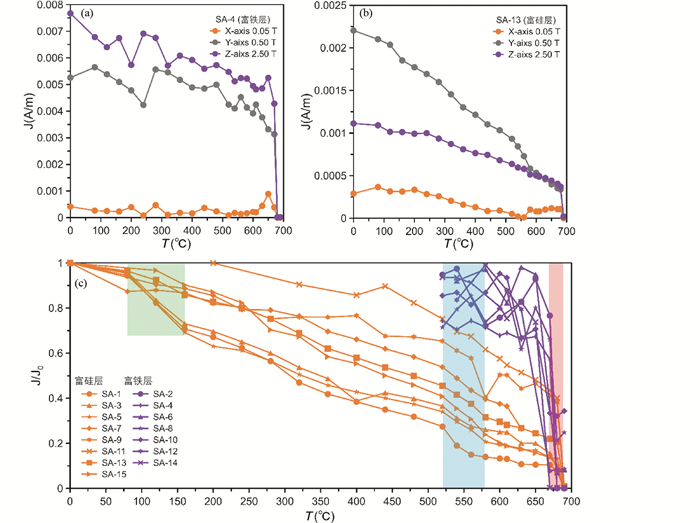
|
图 6 典型样品的Lowrie三轴热退磁曲线(a、b,据Lowrie, 1990)及IRM热退磁曲线图(c) Fig. 6 Stepwise thermal demagnetization of a three-component IRM for typical specimens (a, b, after Lowrie, 1990) and progressive thermal demagnetization curves of silica- and iron-rich layers specimens (c) |
图 7为富硅层和富铁层部分的k-T曲线,SA-5、SA-7为富硅层样品,SA-10、SA-14为富铁层样品。在加热过程中,温度低于400℃时富硅层与富铁层样品的磁化率呈现缓慢上升趋势;温度大于400℃之后,磁化率逐步上升,主要是由于在加热过程中含铁硅酸盐分解生成新的磁性矿物。温度达到585℃左右,磁化率迅速下降,表明其中含有磁铁矿。随后,磁化率平缓变化,在680℃再次迅速下降,表明其中含有赤铁矿。冷却曲线明显高于加热曲线,进一步说明在加热过程中生成新的磁性矿物。
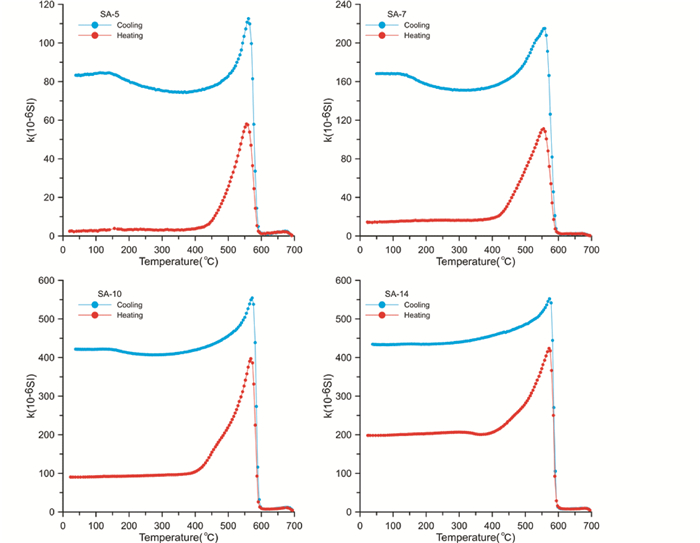
|
图 7 富铁层和富硅层部分的k-T曲线 SA-5、SA-7:富硅层;SA-10、SA-14:富铁层 Fig. 7 k-T curves of partial silica-rich layers (SA-5, SA-7) and iron-rich layers (SA-10, SA-14) |
不同的亚铁磁性矿物具有各自磁性特征,这为通过岩石磁学测量评估样品中的磁性矿物组成提供了依据。样品的饱和磁化强度值表明,研究样品中富铁层的磁性矿物含量接近富硅层中磁性矿物的10倍。除个别富硅层样品(SA-1、SA-15)与富铁层样品(SA-2)外,研究区巴伯顿条带状铁建造样品的磁滞回线呈现典型的“鹅颈形”特征,表明其中含有两种不同类型或不同粒度的磁性矿物相混合。研究者通过模拟发现,当赤铁矿与磁铁矿混合时,磁滞回线会表现为“鹅颈形”,即不同类型或粒度的磁性矿物相互混合时,磁化强度呈线性叠加而矫顽力呈非线性叠加,且在磁铁矿含量高于5%时,磁滞回线将无法表现赤铁矿的信息,而等温剩磁获得曲线依旧可以呈现赤铁矿的信息(即使磁铁矿的含量高达10%)(Ahmadzadeh et al., 2018; Carvallo et al., 2006)。等温剩磁获得曲线及矫顽力分析,我们可以确定富硅层样品中主要含有两种不同高矫顽力的硬磁矿物(如赤铁矿,针铁矿)以及一种低矫顽力的软磁矿物(如磁铁矿);富铁层中主要含有一种高矫顽力的磁性矿物和一种中矫顽力的磁性矿物,但不排除粒度的影响(Day et al., 1977; Dunlop, 1986; Kneller and Luborsky, 1963)。
磁铁矿和赤铁矿具有完全不同的低温转变温度。标准化学计量合成的磁铁矿在120~125K发生Verwey转变,在此温度之上磁铁矿晶格从单斜结构转变为立方反尖晶石结构。赤铁矿则在~250K发生Morin转变,磁矩由垂直晶体c轴排列变为平行c轴排列。这两种低温相变分别是磁铁矿和赤铁矿的固有属性。测试BIFs样品的富硅层与富铁层均出现明显的Verwey转变和Morin转变,同时,结合k-T曲线呈现出585℃居里温度点680℃尼尔温度点的特征,表明磁性矿物由磁铁矿和赤铁矿组成,这与前人对BIFs中磁性矿物研究认识一致(Beukes, 1973; James, 1954; Li et al., 2014; Posth et al., 2011; Sun and Li, 2017)。此外,我们通过Lowrie三轴IRM热退磁曲线发现,除个别富硅层样品的剩磁在80~160℃出现明显下降表明其中可能含有少量针铁矿外,其余富硅层与富铁层样品的剩磁均在550~580℃和660~680℃出现急剧下降,进一步证明样品中主要载磁矿物为磁铁矿与赤铁矿。对于富硅层中等温剩磁获得曲线的矫顽力谱分析显示,富硅层中含有两种不同的高矫顽力磁性矿物,可能是因为其中含有相对细颗粒的赤铁矿(Kletetschka and Wasilewski, 2002; Özdemir and Dunlop, 2014),或含有不同形态特征的赤铁矿(Tadić et al., 2011)。根据样品Morin转变温度介于250~260K,我们推测样品中赤铁矿粒径主要介于0.5~6mm(Özdemir et al., 2008),磁畴状态表现为多畴(Kletetschka and Wasilewski, 2002)。结合富硅层FORC图主要表现为中间呈现闭合,延纵轴延伸表现为半封闭特征,说明富硅层中磁铁矿主要为假单畴颗粒(0.1~1μm),同时含有一定量超顺磁性磁铁矿颗粒(< 0.025μm), 这得到低温测量中剩磁在25K快速下降观测支持。富铁层FORC图表现为中间闭合向外延伸逐渐表现半闭合,说明其中磁铁矿主要为多畴(>0.1μm)和假单畴(0.1~1μm)颗粒(Roberts et al., 2014; Roberts et al., 2000;秦华峰等, 2008)。
Robertson and France (1994)首次提出利用高斯累方程对IRM获得曲线进行分析可获得测试样品中的磁性矿物特征,其原理主要基于不同的磁性矿物的矫顽力呈现高斯对数叠加。Kruiver et al. (2001)在此基础上建立数学模型定量分析样品中磁性矿物特征。基于Kruiver et al. (2001)提出的矫顽力谱分析模型,通过对BIFs富铁层和富硅层样品的矫顽力谱进行分析,得到富铁层样品中赤铁矿相对含量平均为97.9%,磁铁矿相对含量平均为2.1%;富硅层中赤铁矿相对含量平均为95.4%,磁铁矿相对含量平均为4.6%。
4.2 BIFs中磁铁矿的成因BIFs中磁铁矿的成因一直是人们关注的焦点。Heimann et al. (2010)研究Kuruman BIFs中的碳酸盐,发现其碳同位素、氧同位素、铁同位素具有明显的负偏,认为微生物异化还原作用(DIR)在BIFs形成中扮演重要的角色。Johnson et al. (2008)通过模拟也得出类似的结果。Li et al. (2013)通过模拟发现通过微生物DIR作用生成的磁铁矿与BIFs中的磁铁矿具有类似的特征。同时,生物参与合成的磁铁矿其物理性质与非生物成因磁铁矿也存在明显差异。标准化学计量的磁铁矿的Tv接近125K,而大量的研究证明生物成因的磁铁矿的Tv具有明显的低值. Moskowitz等通过测量实验室纯培养的趋磁细菌后获得的磁铁矿的转换温度,提出将Tv≈100K作为生物成因磁铁矿的辨别标准(Moskowitz et al., 1993)。Pan et al. (2005b)首次测量从碳酸盐质湖泊沉积物中富集的趋磁细菌的磁学低温性质,发现其Verwey转变温度(Tv)约等于110K。后续大量研究表明,从湖泊、海洋沉积物进行磁分选获得的化石磁小体的Tv主要介于100~110K(Chang et al., 2013; Kopp and Kirschvink, 2008; Pan et al., 2005a;韩非等, 2016;刘植等, 2012;潘永信等, 2004)。我们通过测量BIFs富硅层与富铁层的Tv发现,富硅层中(除个别层外)出现两个不同的Tv值(Tv1=105~107K,Tv2=120~125K),这暗示BIFs富硅层中的磁铁矿可能来自生物和非生物两种不同的成因。Chang et al. (2016a)对海洋沉积物中磁铁矿研究也发现类似的特征,并证明是由于同时含有生物成因和非生物成因磁铁矿的缘故。
图 8为BIFs样品中铁氧化颗粒的扫描电镜照片。图 8a中铁氧化物颗粒与现代趋磁细菌合成的磁小体在形态及颗粒排列上具有一定的相似性特征。最近,Lin等通过宏基因组和系统发育树分析提出趋磁细菌起源可至少追溯到3.2Ga以前。因此,我们推测样品中自生物成因磁铁矿有可能是磁小体化石,但这需要将来更多的观测分析检验。不排除早期BIFs中的生物成因的磁铁矿被后期成岩作用转化为赤铁矿等,这里富硅层中生物成因的磁铁矿能够保存下来可能是因为被硅酸盐包裹(Chang et al., 2016a, b )。图 8b中八面体晶形,粒径大于2微米的磁铁矿为非生物成因。

|
图 8 BIFs中铁氧化物的扫描电镜照片 (a)和(b)分别为富硅层、富铁层中铁氧化物颗粒 Fig. 8 SEM images of iron oxides preserved in BIFs (a) and (b) mean iron oxides of silica-rich and iron-rich layers, respectively |
岩石磁学测量分析表明,距今32亿年前的南非巴伯顿绿岩带无花果树群恩圭尼亚组的BIFs中磁性矿物主要为赤铁矿和磁铁矿。富铁层中磁铁矿的含量接近富硅层中含量的10倍。依据矫顽力分析,富铁层赤铁矿相对含量平均为97.9%,磁铁矿相对含量平均为2.1%,其中磁铁矿主要为多畴颗粒及少量假单畴颗粒。富硅层中赤铁矿相对含量平均为95.4%,磁铁矿相对含量平均为4.6%,其中磁铁矿主要为超顺磁-假单畴颗粒,且可能存在生物和非生物两种不同来源。
致谢 感谢王非研究员提供本研究的测试样品,何况博士在文章撰写中给予的有益讨论。感谢两位审稿专家给予宝贵的修改意见。
Ahmadzadeh M, Romero C and McCloy J. 2018. Magnetic analysis of commercial hematite, magnetite, and their mixtures. AIP Advances, 8(5): 056807 DOI:10.1063/1.5006474 |
Beukes NJ. 1973. Precambrian iron-formations of southern Africa. Economic Geology, 68(7): 960-1004 DOI:10.2113/gsecongeo.68.7.960 |
Carvallo C, Muxworthy AR and Dunlop DJ. 2006. First-order reversal curve (FORC) diagrams of magnetic mixtures: Micromagnetic models and measurements. Physics of the Earth and Planetary Interiors, 154(3-4): 308-322 DOI:10.1016/j.pepi.2005.06.017 |
Chang L, Winklhofer M, Roberts AP, Heslop D, Florindo F, Dekkers MJ, Krijgsman W, Kodama K and Yamamoto Y. 2013. Low-temperature magnetic properties of pelagic carbonates: Oxidation of biogenic magnetite and identification of magnetosome chains. Journal of Geophysical Research: Solid Earth, 118(12): 6049-6065 DOI:10.1002/2013JB010381 |
Chang L, Heslop D, Roberts AP, Rey D and Mohamed KJ. 2016a. Discrimination of biogenic and detrital magnetite through a double Verwey transition temperature. Journal of Geophysical Research: Solid Earth, 121(1): 3-14 DOI:10.1002/2015JB012485 |
Chang L, Roberts AP, Heslop D, Hayashida A, Li JH, Zhao X, Tian W and Huang QH. 2016b. Widespread occurrence of silicate-hosted magnetic mineral inclusions in marine sediments and their contribution to paleomagnetic recording. Journal of Geophysical Research: Solid Earth, 121(12): 8415-8431 DOI:10.1002/2016JB013109 |
Crosby HA, Roden EE, Johnson CM and Beard BL. 2007. The mechanisms of iron isotope fractionation produced during dissimilatory Fe(Ⅲ) reduction by Shewanella putrefaciens and Geobacter sulfurreducens. Geobiology, 5(2): 169-189 DOI:10.1111/gbi.2007.5.issue-2 |
Day R, Fuller M and Schmidt VA. 1977. Hysteresis properties of titanomagnetites: Grain-size and compositional dependence. Physics of the Earth and Planetary Interiors, 13(4): 260-267 DOI:10.1016/0031-9201(77)90108-X |
Deng CL, He HY, Pan YX and Zhu RX. 2013. Chronology of the terrestrial Upper Cretaceous in the Songliao Basin, Northeast Asia. Palaeogeography, Palaeoclimatology, Palaeoecology, 385: 44-54 DOI:10.1016/j.palaeo.2012.07.028 |
Dunlop DJ. 1986. Hysteresis properties of magnetite and their dependence on particle size: A test of pseudo-single-domain remanence models. Journal of Geophysical Research: Solid Earth, 91(B9): 9569-9584 DOI:10.1029/JB091iB09p09569 |
Han F, Wang FX, Li JH, Qin HF, Deng CL and Pan YX. 2016. Identification of magnetic minerals in surface sediments of Miyun Lake, Beijing. Chinese Journal of Geophysics, 59(8): 2937-2948 (in Chinese with English abstract) |
Heinrichs T. 1980. Lithostratigraphische Untersuchungen in der Fig Tree Gruppe des Barberton Greenstone Belt zwischen Umsoli und Lomati (Südafrika). Im Selbstverlag des Geologisch-Paläontologischen Instituts der Georg-August-Universität Göttingen, 22: 118 |
Heimann A, Johnson CM, Beard BL, Valley JW, Roden EE, Spicuzza MJ and Beuke NJ. 2010. Fe, C, and O isotope compositions of banded iron formation carbonates demonstrate a major role for dissimilatory iron reduction in ~2.5Ga marine environments. Earth and Planetary Science Letters, 294(1-2): 8-18 DOI:10.1016/j.epsl.2010.02.015 |
Hofmann A. 2005. The geochemistry of sedimentary rocks from the Fig Tree Group, Barberton greenstone belt: Implications for tectonic, hydrothermal and surface processes during Mid-Archaean times. Precambrian Research, 143(1-4): 23-49 DOI:10.1016/j.precamres.2005.09.005 |
James HL. 1954. Sedimentary facies of iron-formation. Economic Geology, 49(3): 235-293 |
Johnson CM, Beard BL, Klein C, Beukes NJ and Roden EE. 2008. Iron isotopes constrain biologic and abiologic processes in banded iron formation genesis. Geochimica et Cosmochimica Acta, 72(1): 151-169 DOI:10.1016/j.gca.2007.10.013 |
Klein C. 2005. Some Precambrian banded iron-formations (BIFs) from around the world: Their age, geologic setting, mineralogy, metamorphism, geochemistry, and origins. American Mineralogist, 90(10): 1473-1499 DOI:10.2138/am.2005.1871 |
Kletetschka G and Wasilewski PJ. 2002. Grain size limit for SD hematite. Physics of the Earth and Planetary Interiors, 129(1-2): 173-179 DOI:10.1016/S0031-9201(01)00271-0 |
Kneller EF and Luborsky FE. 1963. Particle size dependence of coercivity and remanence of single-domain particles. Journal of Applied Physics, 34(3): 656-658 DOI:10.1063/1.1729324 |
Konhauser KO, Robbins LJ, Alessi DS, Flynn SL, Gingras MK, Martinez RE, Kappler A, Swanner ED, Li YL, Crowe SA, Planavsky NJ, Reinhard CT and Lalonde SV. 2017. Phytoplankton contributions to the trace-element composition of Precambrian banded iron formations. GSA Bulletin, 130(5-6): 941-951 |
Kopp RE and Kirschvink JL. 2008. The identification and biogeochemical interpretation of fossil magnetotactic bacteria. Earth-Science Reviews, 86(1-4): 42-61 DOI:10.1016/j.earscirev.2007.08.001 |
Krüner A, Byerly GR and Lowe DR. 1991. Chronology of Early Archaean granite-greenstone evolution in the Barberton Mountain Land, South Africa, based on precise dating by single zircon evaporation. Earth and Planetary Science Letters, 103(1-4): 41-54 DOI:10.1016/0012-821X(91)90148-B |
Kruiver PP, Dekkers MJ and Heslop DJE. 2001. Quantification of magnetic coercivity components by the analysis of acquisition curves of isothermal remanent magnetisation. Earth and Planetary Science Letters, 189(3-4): 269-276 DOI:10.1016/S0012-821X(01)00367-3 |
Lan CY, Zhang LC, Zhao TP, Wang CL, Li HZ and Zhou YY. 2013. Mineral and geochemical characteristics of the Tieshanmiao-type BIF-iron deposit in Wuyang region of Henan Province and its implications for ore-forming processes. Acta Petrologica Sinica, 29(7): 2567-2582 (in Chinese with English abstract) |
Li HZ, Zhai MG, Zhang LC, Yang ZJ, Kapsiotis A, Zhou YZ, He JG, Wang CL and Liang J. 2014. Mineralogical and microfabric characteristics of magnetite in the Wuyang Precambrian BIFs, southern North China Craton: Implications for genesis and depositional processes of the associated BIFs. Journal of Asian Earth Sciences, 94: 267-281 DOI:10.1016/j.jseaes.2014.06.003 |
Li YL, Konhauser KO, Cole DR and Phelps TJ. 2011. Mineral ecophysiological data provide growing evidence for microbial activity in banded-iron formations. Geology, 39(8): 707-710 DOI:10.1130/G32003.1 |
Li YL, Konhauser KO, Kappler A and Hao XL. 2013. Experimental low-grade alteration of biogenic magnetite indicates microbial involvement in generation of banded iron formations. Earth and Planetary Science Letters, 361: 229-237 DOI:10.1016/j.epsl.2012.10.025 |
Liu Z, Liu XM, Li PY and Mao XG. 2012. The magnetic properties of the bacterial sediments in Lake Chiemsee, Germany. Quaternary Sciences, 32(4): 820-824 (in Chinese with English abstract) |
Lowe DR, Byerly GR and Heubeck C. 2012. Geologic Map of the West-central Barberton Greenstone Belt, South Africa. Boulder, Colorado: Geological Society of America
|
Lowrie W. 1990. Identification of ferromagnetic minerals in a rock by coercivity and unblocking temperature properties. Geophysical Research Letters, 17(2): 159-162 DOI:10.1029/GL017i002p00159 |
Moorbath S, O'Nions RK and Pankhurst RJ. 1973. Early Archaean age for the Isua iron formation, West Greenland. Nature, 245(5421): 138-139 DOI:10.1038/245138a0 |
Moskowitz BM, Frankel RB and Bazylinski DA. 1993. Rock magnetic criteria for the detection of biogenic magnetite. Earth and Planetary Science Letters, 120(3-4): 283-300 DOI:10.1016/0012-821X(93)90245-5 |
Muxworthy AR and McClelland E. 2000. Review of the low-temperature magnetic properties of magnetite from a rock magnetic perspective. Geophysical Journal International, 140(1): 101-114 DOI:10.1046/j.1365-246x.2000.00999.x |
Otake T, Wesolowski DJ, Anovitz LM, Allard LF and Ohmoto H. 2010. Mechanisms of iron oxide transformations in hydrothermal systems. Geochimica et Cosmochimica Acta, 74(21): 6141-6156 DOI:10.1016/j.gca.2010.07.024 |
Özdemir Ö, Dunlop DJ, Berquó TS. 2008. Morin transition in hematite: Size dependence and thermal hysteresis. Geochemistry, Geophysics, Geosystems, 9(10): Q10Z01. |
Özdemir Ö, Dunlop DJ. 2014. Hysteresis and coercivity of hematite. Journal of Geophysical Research: Solid Earth, 119(4): 2582-2594. |
Pan YX, Deng CL, Liu QS, Petersen N and Zhu RX. 2004. Biomineralization and magnetism of bacterial magnetosomes. Chinese Science Bulletin, 49(24): 2563-2568 DOI:10.1360/982004-153 |
Pan YX, Petersen N, Davila AF, Zhang LM, Winklhofer M, Liu QS, Hanzlik M and Zhu RX. 2005a. The detection of bacterial magnetite in recent sediments of Lake Chiemsee (southern Germany). Earth and Planetary Science Letters, 232(1-2): 109-123 DOI:10.1016/j.epsl.2005.01.006 |
Pan YX, Petersen N, Winklhofer M, Davila AF, Liu QS, Frederichs T, Hanzlik M and Zhu RX. 2005b. Rock magnetic properties of uncultured magnetotactic bacteria. Earth and Planetary Science Letters, 237(3-4): 311-325 DOI:10.1016/j.epsl.2005.06.029 |
Posth NR, Konhauser KO and Kappler A. 2011. Banded iron formations. In: Reitner J and Thiel V (eds.). Encyclopedia of Geobiology. Dordrecht: Springer, 92-103
|
Qin HF, Liu QS and Pan YX. 2008. The first-order reversal curve (FORC) diagram: Theory and case study. Chinese Journal of Geophysics, 51(3): 743-751 (in Chinese with English abstract) |
Raye U, Pufahl PK, Kyser TK, Ricard E and Hiatt EE. 2015. The role of sedimentology, oceanography, and alteration on the δ56Fe value of the Sokoman iron formation, Labrador Trough, Canada. Geochimica et Cosmochimica Acta, 164: 205-220 DOI:10.1016/j.gca.2015.05.020 |
Roberts AP, Pike CR and Verosub KL. 2000. First-order reversal curve diagrams: A new tool for characterizing the magnetic properties of natural samples. Journal of Geophysical Research: Solid Earth, 105(B12): 28461-28475 DOI:10.1029/2000JB900326 |
Roberts AP, Heslop D, Zhao X and Pike CR. 2014. Understanding fine magnetic particle systems through use of first-order reversal curve diagrams. Reviews of Geophysics, 52(4): 557-602 |
Robertson DJ and France DE. 1994. Discrimination of remanence-carrying minerals in mixtures, using isothermal remanent magnetisation acquisition curves. Physics of the Earth and Planetary Interiors, 82(3-4): 223-234 DOI:10.1016/0031-9201(94)90074-4 |
Rochette P, Fillion G, Mattéi JL and Dekkers MJ. 1990. Magnetic transition at 30~34 Kelvin in pyrrhotite: Insight into a widespread occurrence of this mineral in rocks. Earth and Planetary Science Letters, 98(3-4): 319-328 DOI:10.1016/0012-821X(90)90034-U |
Sun S and Li YL. 2017. Microstructures, crystallography and geochemistry of magnetite in 2500 to 2200 million-year-old banded iron formations from South Africa, Western Australia and North China. Precambrian Research, 298: 292-305 DOI:10.1016/j.precamres.2017.06.015 |
Tadić M, Čitaković N, Panjan M, Stojanović Z, Marković D and Spasojević V. 2011. Synthesis, morphology, microstructure and magnetic properties of hematite submicron particles. Journal of Alloys and Compounds, 509(28): 7639-7944 DOI:10.1016/j.jallcom.2011.04.117 |
Trendall AF. 2002. The significance of iron-formation in the Precambrian stratigraphic record. In: Altermann W and Corcoran PL (eds.). Precambrian Sedimentary Environments: A Modern Approach to Ancient Depositional Systems. Oxford, UK: Blackwell Publishing Ltd., 33-66
|
Verwey EJW. 1939. Electronic conduction of magnetite (Fe3O4) and its transition point at low temperatures. Nature, 144(3642): 327-328 |
Wang CL, Dai YP, Liu L and Zhang LC. 2011. The formative age of BIF and its research methods. Acta Mineralogica Sinica, 31(Suppl.1): 454-456 (in Chinese) |
Wu WF, Li YL and Pan YX. 2012. Microbial mineralization in Precambrian banded iron formations. Chinese Journal of Geology, 47(2): 548-560 (in Chinese) |
Zhao ZH. 2010. Banded iron formation and related great oxidation event. Earth Science Frontiers, 17(2): 1-12 (in Chinese with English abstract) |
韩非, 王芙仙, 李金华, 秦华峰, 邓成龙, 潘永信. 2016. 北京密云水库表层沉积物磁性矿物的鉴别. 地球物理学报, 59(8): 2937-2948. |
兰彩云, 张连昌, 赵太平, 王长乐, 李红中, 周艳艳. 2013. 河南舞阳铁山庙式BIF铁矿的矿物学与地球化学特征及对矿床成因的指示. 岩石学报, 29(7): 2567-2582. |
刘植, 刘秀铭, 李平原, 毛学刚. 2012. 德国Chiemsee湖磁性细菌干湖泥的磁学性质. 第四纪研究, 32(4): 820-824. DOI:10.3969/j.issn.1001-7410.2012.04.28 |
潘永信, 邓成龙, 刘青松, Petersen N, 朱日祥. 2004. 趋磁细菌磁小体的生物矿化作用和磁学性质研究进展. 科学通报, 49(24): 2505-2510. DOI:10.3321/j.issn:0023-074X.2004.24.001 |
秦华峰, 刘青松, 潘永信. 2008. 一阶反转曲线(FORC)图的原理及应用实例. 地球物理学报, 51(3): 743-751. DOI:10.3321/j.issn:0001-5733.2008.03.015 |
王长乐, 代堰锫, 刘利, 张连昌. 2011. BIF的形成时代及其研究方法. 矿物学报, 31((增1): 454-456. |
吴文芳, 李一良, 潘永信. 2012. 微生物参与前寒武纪条带状铁建造沉积的研究进展. 地质科学, 47(2): 548-560. DOI:10.3969/j.issn.0563-5020.2012.02.021 |
赵振华. 2010. 条带状铁建造(BIF)与地球大氧化事件. 地学前缘, 17(2): 1-12. |
 2019, Vol. 35
2019, Vol. 35



